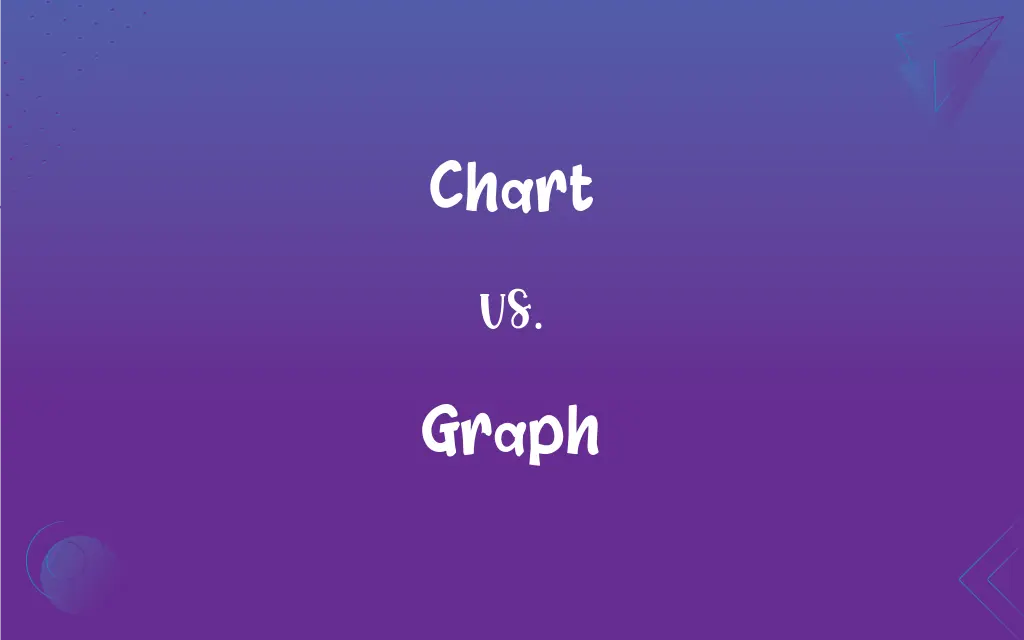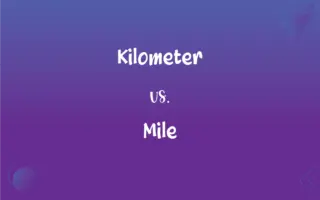Chart vs. Graph: What's the Difference?
Edited by Harlon Moss || By Janet White || Published on December 2, 2023
Chart refers to a visual representation of data or information, often in diagram form. Graph refers to a diagram showing the relationship between variables, typically along axes.

Key Differences
A chart is a visual tool used to represent data or information, which can include formats like flowcharts, pie charts, or bar charts. However, graphs are a type of chart specifically used to depict relationships between different variables, usually on a coordinate system.
Charts encompass a broader range of data presentations, including organizational and process diagrams. In contrast, graphs focus on numerical data, emphasizing trends and patterns through lines, bars, or points.
The purpose of a chart is often to simplify and clarify complex information or data. Graphs, whereas, are designed to provide a clear illustration of quantitative relationships.
Charts can be used in various contexts, from business to education, for diverse types of information. Graphs are predominantly used in scientific and mathematical contexts to represent statistical data.
The design of a chart varies widely, adapting to the type of data or information it presents. Graphs typically adhere to a standard format, using axes to plot data points.
ADVERTISEMENT
Comparison Chart
Definition
A visual representation of data or information.
A diagram showing relationships between variables.
Variety
Includes various types like pie, bar, flowcharts.
Specifically uses lines, bars, points on axes.
Purpose
To simplify and clarify complex data.
To illustrate quantitative relationships.
Usage Context
Broad, including business, education, etc.
Mostly in scientific, mathematical contexts.
Design Flexibility
Wide range of designs.
Typically adheres to a standard format.
ADVERTISEMENT
Chart and Graph Definitions
Chart
Any diagrammatic or pictorial representation of information.
She used a flow chart to explain the process.
Graph
A representation of data on axes.
The graph depicted the company's revenue growth.
Chart
A visual display of information or data.
The project's timeline was outlined in a Gantt chart.
Graph
A diagram showing the relationship between variables.
The temperature changes were plotted on a line graph.
Chart
A graphical representation of data.
The sales data was presented in a bar chart.
Graph
A plot of values on a coordinate system.
The graph of the equation formed a parabola.
Chart
A visual summary of data or processes.
The organization chart displayed the company's structure.
Graph
A mathematical diagram used to show trends.
He analyzed the graph to understand market fluctuations.
Chart
A schematic representation, often used in navigation or meteorology.
The captain referred to the nautical chart for guidance.
Graph
A visual representation of statistical data.
The scatter graph showed a clear correlation between the variables.
Chart
A map showing coastlines, water depths, or other information of use to navigators.
Graph
A diagram that exhibits a relationship, often functional, between two sets of numbers as a set of points having coordinates determined by the relationship. Also called plot.
Chart
An outline map on which specific information, such as scientific data, can be plotted.
Graph
A pictorial device, such as a pie chart or bar graph, used to illustrate quantitative relationships. Also called chart.
FAQs
Can a graph be a chart?
Yes, a graph is a specific type of chart.
What's a common use for charts?
To simplify and present data or information visually.
Are all charts graphs?
No, not all charts are graphs; charts have a broader scope.
What is a chart?
A visual representation of data or information in various formats.
What is a graph?
A diagram showing relationships between variables on axes.
What types of charts are there?
Pie charts, bar charts, flowcharts, etc.
What's a common use for graphs?
To illustrate quantitative relationships in data.
Do charts always show numerical data?
No, charts can present various types of information.
Do graphs always use axes?
Typically, yes, graphs use axes to plot data.
Can charts be used in business?
Yes, widely used for presentations and reports.
Can charts be interactive?
Yes, especially in digital formats.
Is a histogram a chart or a graph?
It's a type of graph, and thus a specific form of chart.
What types of graphs are common?
Line graphs, bar graphs, and scatter plots.
Do charts need a legend?
Often, to explain symbols or colors used.
Are graphs used in science?
Yes, extensively for representing experimental data.
What skills are needed to create charts?
Understanding of data and basic design principles.
Can graphs be misleading?
Yes, if not accurately representing the data.
Is a pie chart a graph?
It's a type of chart, but not typically categorized as a graph.
Are graphs better than tables?
Depends on the data; graphs show trends, tables show precise values.
What skills are needed to create graphs?
Numerical literacy and understanding of graphing techniques.
About Author
Written by
Janet WhiteJanet White has been an esteemed writer and blogger for Difference Wiki. Holding a Master's degree in Science and Medical Journalism from the prestigious Boston University, she has consistently demonstrated her expertise and passion for her field. When she's not immersed in her work, Janet relishes her time exercising, delving into a good book, and cherishing moments with friends and family.
Edited by
Harlon MossHarlon is a seasoned quality moderator and accomplished content writer for Difference Wiki. An alumnus of the prestigious University of California, he earned his degree in Computer Science. Leveraging his academic background, Harlon brings a meticulous and informed perspective to his work, ensuring content accuracy and excellence.






































































